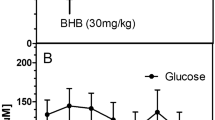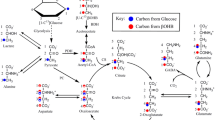Abstract
Previous studies have shown that 1,3-butanediol (BD) has beneficial effects in experimental models of hypoxia or ischemia but the mechanism by which it exerts its protective effects remains unknown. BD is converted in the body to β-hydroxybutyrate (BHB) and it has been proposed that its effects were linked to its ketogenic effect. The effects of BD (25 and 50 mmol/kg) on cerebral energy metabolism of rats were studied by measuring the cerebral level of energy metabolites and by evaluating the cerebral metabolic rate according to the Lowry's method. BD induced an increase in [cortical glucose]/[plasma glucose] ratio which was associated with a decrease in lactate level and an increase in glucose and glycogen stores. In contrast, BHB treatment which mimicked hyperketonemia equivalent to BD did not modify cerebral glycolysis metabolites. Calculation of the energy reserve flux after decapitation showed that BD did not reduce the cerebral metabolic rate excluding a protective effect due to a depressant, barbiturate-like, action. These results suggest that BD induces a reduction of cerebral glycolytic rate. However, the effect is not linked to hyperketonemia but might be due to intracerebral conversion of BD to BHB.
Similar content being viewed by others
References
Combs, D.J., and D'Alecy, L.G. (1987). Motor performance in rats exposed to severe forebrain ischemia: effect of fasting and 1,3-butanediol.Stroke 18: 503–511.
Dagnelie, P. (1975).Théorie et méthodes statistiques., Les presses agronomiques de Gembloux, Belgique.
De Vivo, D.C., Leckie, M.P., Ferrendelli, J.S., and McDougal, D.B. (1978). Chronic ketosis and cerebral metabolism.Ann. Neurol. 3: 331–337.
Demerle-Pallardy, C., Duverger, D., Spinnewyn, B., Pirotzky, E., and Braquet, P. (1991). Peripheral type benzodiazepine binding sites following transient forebrain ischemia in the rat: effect of neuroprotective drugs.Brain Res. 565: 312–320.
Eiger, S.M., Kirsch, J.R., and D'Alecy, L.G. (1980). Hypoxic tolerance enhanced by β-hydroxybutyrate-glucagon in the mouse.Stroke 11: 513–517.
Folbergrova, J., Lowry, O.H., and Passonneau, J.V. (1970). Changes in metabolites of the energy reserves in individual layers of mouse cerebral cortex and subjacent white matter during ischaemia and anesthesia.J. Neurochem. 17: 1155–1162.
Folbergrova, J., Ponten, U., and Siesjö, B.K. (1972). Patterns of changes in brain carbohydrate metabolites, aminoacids and organic phosphates at increased carbon dioxide tensions.J. Neurochem. 22: 1115–1125.
Frye, G.D., Chapin, R.E., Vogel, R.A., Mailman, R.B., Kilts, C.D., Mueller, R.A., and Breese, G.R. (1981). Effects of acute and chronic 1,3-butanediol treatment on central nervous system function: a comparison with ethanol.J. Pharmacol. Exp. Ther. 216: 306–314.
Gjedde, A., and Crone, C. (1975). Induction processes in blood-brain transfer of ketone bodies during starvation.Am. J. Physiol. 229: 1165–1169.
Gueldry, S., Marie, C., Rochette, L., and Bralet, J. (1990). Beneficial effect of 1,3-butanediol on cerebral energy metabolism and edema following brain embolization in rats.Stroke 21: 1458–1463.
Gueldry, S., Marie, C., Christofi, G., Sarna, G.S., and Obrenovitch, T.P. (1994). Changes in extracellular and rat brain tissue concentrations of D-β-hydroxybutyrate after 1,3-butanediol treatment.J. Neurochem. 62: 223–226.
Kirsch, J.R., and D'Alecy, L.G. (1979). Effect of altered availability of energy-yielding substrates upon survival from hypoxia in mice.Stroke 10: 288–291.
Kirsch, J.R., D'Alecy, L.G., and Mongroo, P. (1980). Butanediol induced ketosis increases tolerance to hypoxia in the mouse.Stroke 11: 506–513.
Kirsch, J.R., and D'Alecy, L.G. (1984). Hypoxia induced preferential ketone utilization by rat brain slices.Stroke 15: 319–323.
Kogure, K., Busto, R., Scheinberg, P., and Reinmuth, O. (1975). Dynamics of cerebral metabolism during moderate hypercapnia.J. Neurochem. 24: 471–478.
Kuschinsky, W., Suda, S., and Sokoloff, L. (1981). Local cerebral glucose utilization and blood flow during metabolic acidosis.Am. J. Physiol. 241: H 772-H 777.
Levy, D.E., and Duffy, T.E. (1975). Effect of ischemia on energy metabolism in the gerbil cerebral cortex.J. Neurochem. 24: 1287–1289.
Lowry, O.H., Passonneau, J.V., Hasselberger, F.X., and Schultz, D.W. (1964). Effect of ischemia on known substrates and cofactors of the glycolytic pathway in brain.J. Biol. Chem. 239: 18–30.
Lowry, O.H., and Passonneau, J.V. (1972).A Flexible System of Enzymatic Analysis., Academic Press, New York.
Lundgren, J., Smith, M.J., Mans, A.M., and Siesjö, B.K. (1992). Ischemic brain damage is not ameliorated by 1,3-butanediol in hyperglycemic rats.Stroke 23: 719–724.
Lundy, E.F., Luyckx, A., Combs, D.J., Zelenock, G., and D'Alecy, L.G. (1984). Butanediol induced cerebral protection from ischemic-hypoxia in the instrumented Levine rat.Stroke 15: 547–552.
Lundy, E.F., Dykstra, J., Luyckx, B., Zelenock, G.B., and D'Alecy L.G. (1985). Reduction of neurologic deficit by 1,3-butanediol induced ketosis in Levine rats.Stroke 16: 855–860.
Lundy, E.F., Klima, L.D., Huber, T.S., Zelenock, G.B., and D'Alecy, LG (1987). Elevated blood ketone and glucagon levels cannot account for 1,3-butanediol induced cerebral protection in the Levine rat.Stroke 18: 217–222.
Lust, W.D., Passonneau, J.V., and Crites, S.K. (1975). The measurement of glycogen in tissues by amylo-α-1,6-glucosidase after destruction of preexisting glucose.Analyt. Biochem. 68: 328–331.
MacMillan, V. (1988). Influence of ethanol on the energy metabolism of ischemic and postischemic brain.J. Cereb. Blood Flow Metab. 8: 335–340.
Marie, C., Bralet, A.M., and Bralet J. (1987). Protective action of 1,3-butanediol in cerebral ischemia. A neurologic, histologic, and metabolic study.J Cereb. Blood Flow Metab. 7: 794–800.
Marie, C., Bralet, A.M., Gueldry, S., and Bralet, J. (1990). Fasting prior to transient cerebral ischemia reduces delayed neuronal necrosis.Metab. Brain Dis. 5: 65–75.
Miller, A.L., Kiney, C.A., Corddry, D.H., and Staton, D.M. (1982). Interactions between glucose and ketone body use by developing brain.Dev. Brain Res. 4: 443–450.
Myles, W.S. (1976). Survival of fasted rats exposed to altitude.Can. J. Pharmacol. 54: 883–886.
Nilsson, B., Norberg, K., Nordström, C.H., and Siesjö, B.K. (1975). Rate of energy utilization in the cerebral cortex of rats.Acta Physiol. Scand. 93: 569–571.
Nordström, C.H., and Siesjö, B.K. (1978). Influence of phenobarbital on changes in the metabolites of the energy reserve of the cerebral cortex following complete ischemia.Acta Physiol. Scand. 104: 271–280.
Pardridge, W.M. (1983). Brain metabolism: a perspective from the blood-brain barrier.Physiol. Rev. 63: 1481–1535.
Pollay, M., and Stevens, F. (1980). Starvation-induced changes in transport of ketone bodies across the blood-brain barrier.J. Neurosci. Res. 5: 163–172.
Ponten, U., Ratcheson, R.A., Salford, L.G., and Siesjö, B.K. (1973). Optimal freezing conditions for cerebral metabolites in rats.J. Neurochem. 21: 1127–1138.
Raskin, N.H., and Sokoloff, L. (1970). Alcohol dehydrogenase activity in rat brain and liver.J. Neurochem. 17: 1677–1687.
Raskin, N.H., and Sokoloff, L. (1972). Enzymes catalysing ethanol metabolism in neural and somatic tissues of the rat.J. Neurochem. 19: 273–282.
Ratcheson, R.A., Bilezikjian, L., and Ferrendelli, J.A. (1977). Effect of nitrous oxide anaesthesia upon energy metabolism.J. Neurochem. 28: 223–225.
Robertson, C.S., Goodman, J.C., Narayan, R.K., Contant, C.F., and Grossman, R.G. (1991). The effect of glucose administration on carbohydrate metabolism after head injury.J. Neurosurg. 74: 43–50.
Roucher, P., Corrèze, J.L., Méric, P., Seylaz, P., Mispelter, J., Tiffon, B., and Lhost, J.M. (1991). 1,3-Butanediol protects the brain's energy-producing capacity during reversible ischemia (abstract).J. Cereb. Blood Flow Metab. 11 (suppl 2) : S748.
Ruderman, N.B., Ross, P.S., Berger, M., and Goodman, M.N. (1974). Regulation of glucose and ketone-body metabolism in brain of anaesthetized rats.Biochem. J. 138: 1–10.
Shapiro, H.M. (1985). Barbiturates in brain ischemia.Brit. J. Anaesth. 57: 82–95.
Siesjö, B.K., Folbergrova, J., and MacMillan, V. (1972). The effect of hypercapnia upon intracellular pH in the brain evaluated by the bicarbonate-carbonic acid method and the creatine phosphokinase equilibrium.J. Neurochem. 19: 2483–2495.
Siesjö, BK (1981). Cell damage in the brain: a speculative synthesis.J. Cereb. Blood Flow Metab. 1: 155–185.
Sokoloff, L. (1973). Metabolism of ketone bodies by the brain.Ann. Rev. Med. 24: 271–280.
Tate, R.L., Mehlman, M.A., and Tobin, R. (1971). Metabolic fate of 1,3-butanediol in the rat: conversion to β-hydroxybutyrate.J. Nutr. 101 : 1719–1726.
Williamson, D.H., and Mellanby, J. (1974). D-(-)-3-hydroxybutyrate. In Bergmeyer, H.U. (ed.),Methods of enzymatic analysis, Academic Press, New York, pp. 1836–1839.
Yager, J.Y., Brucklacher, R.M., and Vannucci, R.C. (1991). Effect of mild hypoglycemia on hypoxic-ischemic brain damage in the immature rat (abstract).J. Cereb. Blood Flow Metab. 11 (suppl 2) : S198.
Author information
Authors and Affiliations
Rights and permissions
About this article
Cite this article
Gueldry, S., Bralet, J. Effect of 1,3-butanediol on cerebral energy metabolism. Comparison with β-hydroxybutyrate. Metab Brain Dis 9, 171–181 (1994). https://doi.org/10.1007/BF01999770
Received:
Accepted:
Issue Date:
DOI: https://doi.org/10.1007/BF01999770




